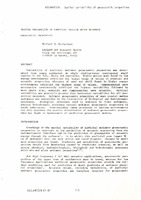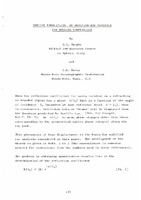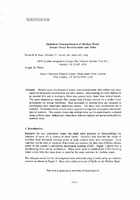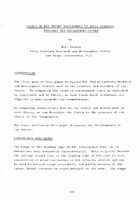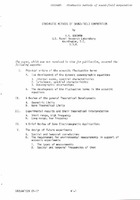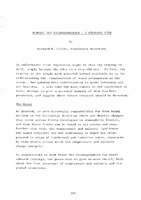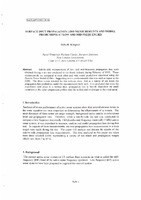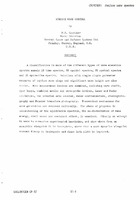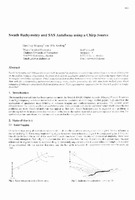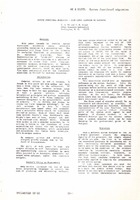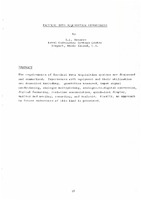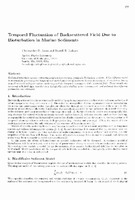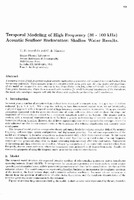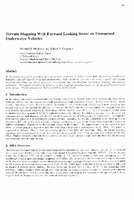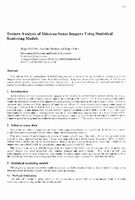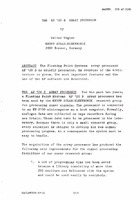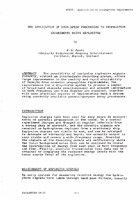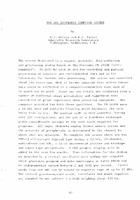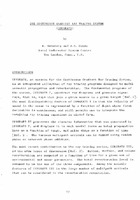Browsing by Type "Conference Proceedings (CP)"
Now showing items 261-280 of 314
-
Spatial variability of surficial shallow water sediment geoacoustic properties
(NATO. SACLANTCEN, 1986/06)Variability of surficial sediment geoacoustic properties was determined from cores collected at eight shallow-water continental shelf regions in the U.S., Italy and Australia. Highly porous muds found in low energy ... -
Special formulation of modified ray analysis for machine computation
(NATO. SACLANTCEN, 1971/12) -
Statistical characterization of shallow-water bistatic sonar reverberation and noise
(NATO. SACLANTCEN, 1993/08)Shallow-water, low-frequency bistatic sonar measurements often exhibit high noise caused by bathymetric reverberation and other sources. Understanding the noise statistics is an essential first step in developing filters ... -
Statistical evaluation of 80 kHz shallow-water seafloor reverberation
(NATO. SACLANTCEN, 1997)In this work a comparison is presented between 80 kHz reverberation statistics obtained at shallow water sites around Sardinia and Sicily. The data include measurements from several distinct bottom provinces, including ... -
Status of ray theory development of Naval Undersea Research and Development Center
(NATO. SACLANTCEN, 1971/12)The first part of this paper discusses NUC (Naval Undersea Research and Development Center) work on the accuracy and validity of ray theory. By comparing the range to convergence zones as indicated by experiment and by ... -
Stochastic methods of sound-field computation
(NATO. SACLANTCEN, 1975/10) -
Summary and recommendations
(NATO. SACLANTCEN, 1971/12)An unfortunate first impression might be that ray tracing is dull, simply because the idea is a very old one. In fact, ray tracing is the single most powerful method available to us for understanding the complexities of ... -
Surface duct propagation loss measurements and model predictions at low and mid frequencies
(NATO. SACLANTCEN, 1993/08)Side-by-side measurements of low- and mid-frequency propagation loss were obtained during a sea test conducted in the North Atlantic during February of 1992. These measurements are compared to each other and with model ... -
Surface wave spectra
(NATO. SACLANTCEN, 1975/10)A classification is made of the different types of wave elevation spectra namely lD time spectra, lD spatial spectra, 2D spatial spectra and 3D space-time spectra. Relations with simple single parameter measures of surface ... -
Swath bathymetry and SAS autofocus using a Chirp source
(NATO. SACLANTCEN, 1997)Swath bathymetry and SAS autofocus can both be treated as problems in correlating echoes from a scatterer distribution on the seabed. Using a chirp source, the phase derived from quadrature match-filtering can replace the ... -
System functional migration: high-level language to hardware
(NATO. SACLANTCEN, 1979/12)This paper intends to examine system functional allocation among available processing resources in a systematic way. The discussion will focus first on the criteria for assigning functions to processors, that is, horizontal ... -
Tactical data acquisition experiences
(NATO. SACLANTCEN, 1972/05)The requirements of Tactical Data Acquisition systems are discussed and summarized. Experiences with equipment and their utilization are described including : quantities measured, input signal conditioning, analogue ... -
Temporal fluctuation of backscattered field due to bioturbatioon in marine sediments
(NATO. SACLANTCEN, 1997)Biological activity in marine sediments creates a time-varying, randomly fluctuating medium. A bio-diffusive model is proposed for predicting the temporal and spatial spectrum of sediment density fluctuations. Perturbation ... -
Temporal modeling of high frequency (30-100 kHz) acoustic seafloor backscatter: shallow water results
(NATO. SACLANTCEN, 1997)A temporal model of high frequency seafloor acoustic backscatter is presented and compared to recorded echoes from terrigenous sediments. Using acoustic properties correlated with mean grain size, the echo shapes and ... -
Terrain mapping with forward looking sonar on unmanned underwater vehicles
(NATO. SACLANTCEN, 1997)In the future, successful reconnaissance operations conducted in shallow water with Autonomous Underwater Vehicles will rely heavily on a high performance, high resolution, forward look sonar coupled with terrain mapping ... -
Texture analysis of sidescan sonar imagery using statistical scattering models
(NATO. SACLANTCEN, 1997)It is shown that the generalised K-distribution provides a good fir to the amplrtude statisttcs of sonar imagery from several different types of seabed sediment. A number of possible explanations for the Ricean nature of ... -
The AP-120B array processor
(NATO. SACLANTCEN, 1979/12)The Floating Point Systems array processor AP 120 B is briefly presented. An overview of the architecture is given. The most important features and the use of the AP software are described -
The application of high-speed processors to propagation experiments using explosives
(NATO. SACLANTCEN, 1979/12)The possibility of analysing explosive signals directly, without an intermediate recording system, offers large improvement~ in the quality and rapid availability of results from acoustic propagation experiments. The ... -
The ARL shipborne computer system
(NATO. SACLANTCEN, 1972/05) -
The continuous gradient ray tracing system (CONGRATS)
(NATO. SACLANTCEN, 1971/12)CONGRATS, an acronym for the Continuous Gradient Ray Tracing System, is an integrated collection of ray tracing programs designed to model acoustic propagation and reverberation. The fundamental programs of the series, ...
